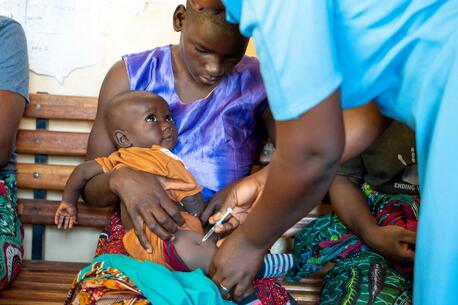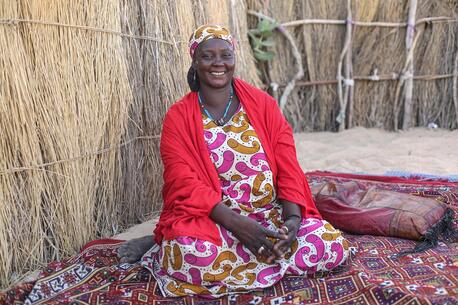Using cartoons to empower children in South Asia
Anyone who thinks back to their favorite childhood programs understands the importance of positive childhood entertainment role models that inform and educate communities. As a child, two of my favorite programs were Sesame Street and Mr. Roger’s Neighborhood. Now in my twenties, on early Saturday mornings I often find myself in front of the television watching Mr. Roger or humming the theme song as I put on my favorite sweater. The social and psychological impact of early childhood education programs last a lifetime. One of UNICEF’s Communication for Development programs is the popular and extremely successful Meena Initiative, which aims to empower the most marginalized, and to prompt debate within homes, schools and community centers.
 Jessica Luckett is a U.S. Fund for UNICEF Program Office intern. Recently we received a visit at our offices from the chief of communications for UNICEF’s Development unit, Rafael Obregon. He and his team—Marina Komarecki, Paula Claycomb and Patricia Portela de Souza—spoke to us about how UNICEF is using communications technology to empower and bring about positive change within communities. UNICEF’s Communication for Development (C4D) team advocates for social, economic and cultural change for women, children and the most vulnerable populations. The objective of the division is to actively promote positive behavior and social change through a human rights-based approach that includes children, families, communities and networks. Anyone who thinks back to their favorite childhood programs understands the importance of positive childhood entertainment role models, as they help inform and educate communities. As a child, two of my favorite programs were Sesame Street and Mr. Roger’s Neighborhood. Now in my twenties, on early Saturday mornings I still often find myself in front of the television watching Mr. Roger or humming the theme song as I put on my favorite sweater. The social and psychological impact of early childhood education programs last a lifetime. One of C4D’s Entertainment Education programs is the popular and extremely successful Meena Initiative, which aims to empower the most marginalized, and to prompt debate within homes, schools and community centers. The Meena program consists of animated films, comic books, radio programs and teacher’s guides, all based around a spirited nine-year-old girl in India who braves the many issues facing children in South Asia. For example, in India, girls as young as nine are eligible to be married off by their families or to be taken out of school because it is generally believed that there is no value in educating girls. The objective of the Meena program is to enhance children’s self-esteem and self-worth, and to empower them by teaching essential life skills. Episodes focus on issues such as safety during natural disasters, preventing child marriage, child labor and human trafficking, water and sanitation, and nutrition. Through Meena, young girls and boys can find their own voice to start a dialog with their parents, friends and teachers about issues that affect them and their community. In 2002, India’s State Education Department took the lead in establishing more than 19,000 girls’ groups, called Meena Manch, throughout India’s most populous state, Uttar Pradesh. A majority of Meena’s followers listen to Radio Meena Ki Duniya, or Meena Radio, that reaches tens of thousands of children in India’s largest state. UNICEF has a similar Entertainment Education program in the Eastern and Southern Africa region using a character named Sara. Due to the success of programs like Meena and Sara, the UNICEF regional office in West and Central Africa is looking to develop a similar program.
Jessica Luckett is a U.S. Fund for UNICEF Program Office intern. Recently we received a visit at our offices from the chief of communications for UNICEF’s Development unit, Rafael Obregon. He and his team—Marina Komarecki, Paula Claycomb and Patricia Portela de Souza—spoke to us about how UNICEF is using communications technology to empower and bring about positive change within communities. UNICEF’s Communication for Development (C4D) team advocates for social, economic and cultural change for women, children and the most vulnerable populations. The objective of the division is to actively promote positive behavior and social change through a human rights-based approach that includes children, families, communities and networks. Anyone who thinks back to their favorite childhood programs understands the importance of positive childhood entertainment role models, as they help inform and educate communities. As a child, two of my favorite programs were Sesame Street and Mr. Roger’s Neighborhood. Now in my twenties, on early Saturday mornings I still often find myself in front of the television watching Mr. Roger or humming the theme song as I put on my favorite sweater. The social and psychological impact of early childhood education programs last a lifetime. One of C4D’s Entertainment Education programs is the popular and extremely successful Meena Initiative, which aims to empower the most marginalized, and to prompt debate within homes, schools and community centers. The Meena program consists of animated films, comic books, radio programs and teacher’s guides, all based around a spirited nine-year-old girl in India who braves the many issues facing children in South Asia. For example, in India, girls as young as nine are eligible to be married off by their families or to be taken out of school because it is generally believed that there is no value in educating girls. The objective of the Meena program is to enhance children’s self-esteem and self-worth, and to empower them by teaching essential life skills. Episodes focus on issues such as safety during natural disasters, preventing child marriage, child labor and human trafficking, water and sanitation, and nutrition. Through Meena, young girls and boys can find their own voice to start a dialog with their parents, friends and teachers about issues that affect them and their community. In 2002, India’s State Education Department took the lead in establishing more than 19,000 girls’ groups, called Meena Manch, throughout India’s most populous state, Uttar Pradesh. A majority of Meena’s followers listen to Radio Meena Ki Duniya, or Meena Radio, that reaches tens of thousands of children in India’s largest state. UNICEF has a similar Entertainment Education program in the Eastern and Southern Africa region using a character named Sara. Due to the success of programs like Meena and Sara, the UNICEF regional office in West and Central Africa is looking to develop a similar program.


